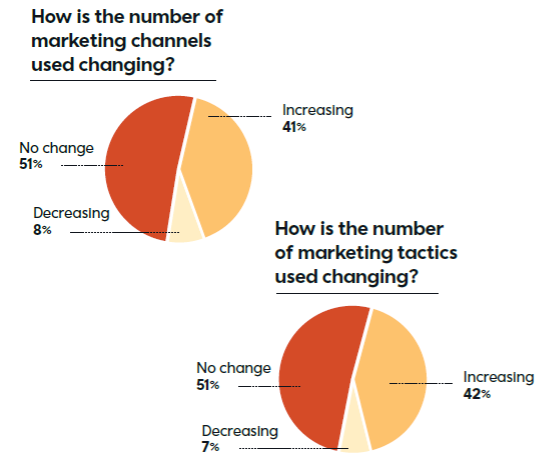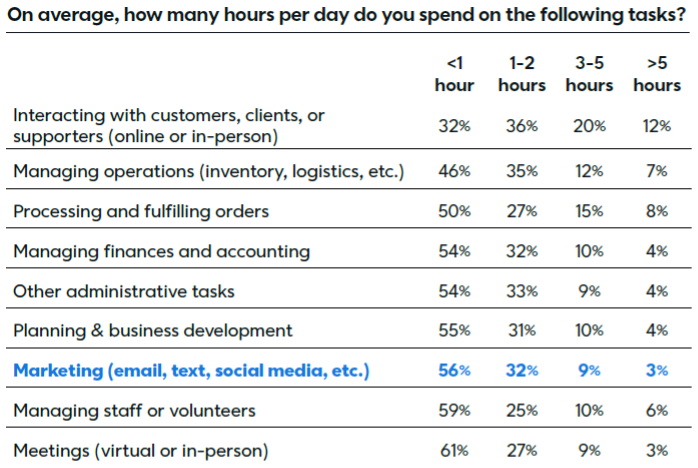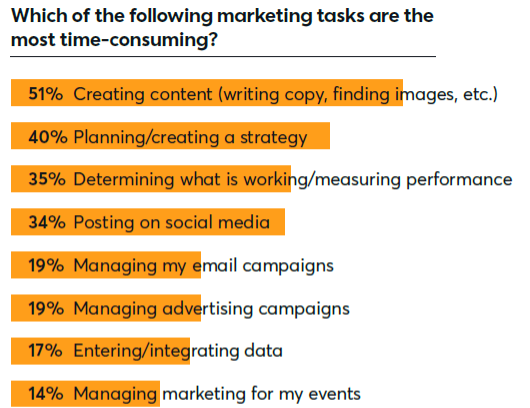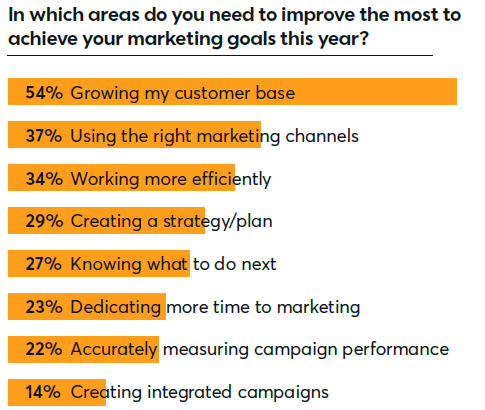
In a world where confidence in marketing strategies is scarce and economic uncertainties loom large, small businesses are on a quest for resilience, seeking to fortify their marketing efforts amidst the relentless pressures of running a business.
The Current State of SMB Marketing, a new research study Ascend2 completed with Constant Contact, uncovered many insights into how SMBs think about marketing and where they need the most assistance.
Small businesses worldwide are grappling with a crisis of confidence in their marketing efforts, with only a quarter feeling assured about the effectiveness of their marketing strategies. This lack of certainty has spurred SMBs to take proactive measures, such as increasing budgets, dedicating more time, and exploring additional marketing channels to enhance performance.
However, despite these efforts, the relentless demands of running a business often leave little time for marketing endeavors, relegating such tasks to the bottom of the list. With most SMBs having less than an hour per day to allocate to marketing, there’s a pressing need for tools and solutions to streamline processes, maximizing efficiency and efficacy.
Amidst economic uncertainties, small businesses find themselves navigating turbulent waters, with over 80% expressing concerns about the potential negative impact of the current economic climate on their operations.
Contributing factors include a persistently robust global economy and challenges such as low unemployment and soaring interest rates. In the United States, the looming specter of a contentious presidential election adds another layer of complexity to the mix, heightening anxieties among small business owners. In such uncertain times, the need for resilient marketing strategies becomes even more pronounced, serving as a beacon of stability amidst a sea of economic volatility.
In the 18-page study, researchers polled 1,335 SMBs in Australia, Canada, the UK, and the US. Here are a few findings from the research and tips you can use to navigate the storm and reach new audiences, optimize marketing campaigns, drive more sales, and grow your business.
Finding #1: Marketing channels and tactics are also increasing
As small businesses strive to expand their marketing efforts by embracing many channels and tactics in 2024, efficiency becomes paramount in their journey toward growth. With over 40% of small business owners aiming to broaden their marketing horizons, time emerges as a crucial factor in their operations.

Finding #1 action plan
As SMBs take on additional responsibilities, finding streamlined and efficient ways to execute their marketing strategies will be pivotal to their success (see this C&C article for best use cases for generative AI). One tip for aiding small businesses in this endeavor is to leverage marketing automation tools. Small businesses can save valuable time and resources by automating repetitive tasks such as email campaigns, social media scheduling, and data analysis while ensuring consistent and effective marketing efforts across multiple channels. Embracing automation increases efficiency and frees up time for SMBs to focus on strategic planning and creative endeavors, ultimately propelling their growth in the competitive landscape of 2024.
Finding #2: Finding the time for marketing
Small businesses are consistently inundated with a multitude of tasks demanding their attention. Amidst the hustle and bustle of managing daily operations, engaging with customers, and fulfilling orders, marketing is frequently relegated to the bottom of the priority list. Surprisingly, more than half of SMBs allocate less than an hour each day to marketing endeavors as they grapple with the immediate demands of running their businesses.

Finding #2 action plan
Implementing a structured schedule can be a game-changer for small businesses struggling to prioritize marketing amidst the daily whirlwind of tasks. Set aside dedicated blocks of time each week solely for marketing activities, treating them with the same importance as other essential business tasks. Whether it’s strategizing content creation, engaging with customers on social media, or analyzing marketing metrics, having designated time slots ensures that marketing efforts receive the attention they deserve. By proactively carving out time for marketing activities, small businesses can effectively elevate their brand presence and reach amidst competing priorities.
Finding #3: Marketing tasks can be time-consuming, so SMBs put them off for later
52% of those surveyed report regularly delaying or postponing their marketing. The most common tactics to be put off for later tend to be the ones that require the most time. According to those surveyed, posting on social media, strategic planning, and measuring performance take too much time.

Finding #3 action plan
To assist small businesses in creating content for marketing purposes effectively and efficiently, consider adopting a strategic approach that leverages available resources and maximizes impact. Begin by understanding your target audience’s preferences, pain points, and interests to tailor content that resonates with them.
Next, establish a content calendar outlining topics, formats, and distribution channels, ensuring consistency in your messaging. Repurpose existing content across multiple channels to maximize reach and engagement while minimizing time and effort. Encourage user-generated content and leverage customer testimonials to add authenticity and credibility to your marketing efforts.
Finally, embrace automation tools for tasks like scheduling posts, analyzing performance metrics, and curating content, freeing up time for strategic planning and creativity. By implementing these strategies, small businesses can create compelling content efficiently while maintaining a consistent brand presence across various channels.
Finding #4: SMBs are focused on improving their channel mix, working more efficiently, and adhering to a strategy
Expansion of their customer base is a top priority for SMBs this year. Still, many report the need to improve their ability to use the right marketing channels, increase efficiency, and create a strategic marketing approach to achieve their goals.

Finding #4 action plan:
Consider a multi-channel marketing strategy to grow your customer base. First, create an integrated and cohesive brand experience across all channels. Start by identifying the most relevant channels for reaching your target audience and develop tailored messaging and content for each platform.
Utilize data analytics to track customer interactions and preferences across channels, allowing for personalized communication and targeted marketing efforts. Embrace consistency in branding, voice, and messaging to build trust and recognition among your audience, regardless of the channel they engage with.
Additionally, leverage cross-channel promotions and incentives to encourage customers to interact with your brand across multiple touchpoints. By seamlessly integrating various channels and delivering a unified brand experience, small businesses can effectively expand their customer base and drive sustainable growth.
Conclusion
As small businesses continue to navigate the complexities of marketing amidst economic uncertainties, the findings from the Ascend2 and Constant Contact research study shed light on actionable insights to bolster their resilience and drive growth.
In the face of limited time and resources, embracing marketing automation emerges as a pivotal strategy to streamline processes and maximize efficiency. By leveraging automation tools to handle repetitive tasks, small businesses can free up valuable time for strategic planning and creative endeavors, propelling their growth in the competitive landscape in 2024.
Furthermore, adopting structured schedules dedicated to marketing activities ensures that these crucial endeavors receive the attention they deserve amidst competing priorities. Proactively carving out time for strategic planning, content creation, and performance analysis empowers small businesses to elevate their brand presence and reach amidst the daily whirlwind of tasks.
Additionally, embracing a multi-channel marketing strategy enables small businesses to expand their customer base effectively, creating integrated and cohesive brand experiences across various touchpoints. By implementing these actionable tips, small businesses can confidently navigate the storm of uncertainty, driving more sales and propelling their businesses toward success in turbulent times.
[Download the full report from Constant Contact]
Need help crafting an effective marketing strategy for SMBs or with saving time by outsourcing content creation? Let’s talk. Schedule time with a Convince & Convert strategist to discuss options.

